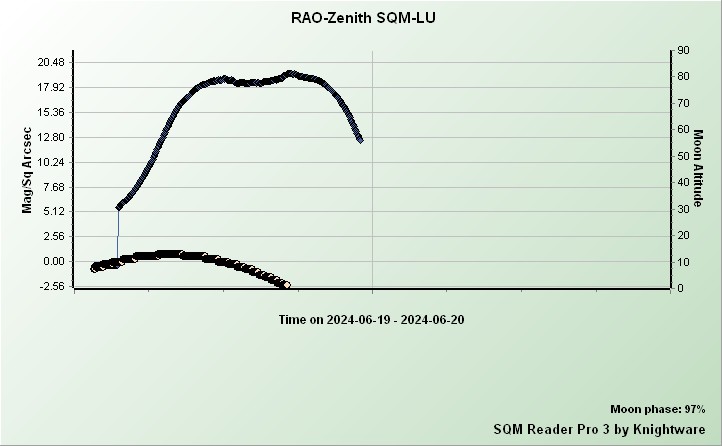Live weather cam
Click on the image to view in your browser. The image will not refresh automatically, so manually refresh your browser's page to update the image. The image is updated approximately every minute.
This camera takes photos of the horizon facing northwest from the RAO. When the sun is setting far to the north, sometimes the direct sunlight can saturate the image. The camera is not sensitive enough to detect stars at night, so nighttime images will be dark. The shed featured in the image (endearingly called "The Cube") houses the RAO Outreach Telescope. To utilize this 14" telescope, the big front door is rolled up and the Cube is pushed back along rails. The Interpretive Center, and the Clark-Milone Telescope are also visible in the image.
Because RAO telescopes are controllable from off-site over the internet, we need to know the current weather conditions at the observatory. The weather cam was set up to monitor these conditions, and the images have been made publicly available.
If you like watching time-lapse video, try out this fun tool, which shows the sequence of images from today (sunrise to sunset);
https://cam01.sci.ucalgary.ca/timelapse/weather/
NOTE: The date and time stamps on the weather cam images are in UTC (not local MST/MDT).
Current sky over the RAO
This is the current sky over the Rothney Astrophysical Observatory. Click on the image to view in your browser. The image will not refresh automatically, so manually refresh the browser's page to update the image. The image is updated every minute .
The AllSky camera is extremely light sensitive, so on clear days the Sun either creates an over exposed column of white light, or the whole image may become overexposed. At night when the clouds are away, planets, stars, constellations, and the Milky Way can be seen (even the Northern Lights! when they are active).
Each AllSky image is oriented such that north is to the right, west is on the bottom, south is to the left and the eastern sky can be seen at the top. The dome seen on the left houses the Baker-Nunn telescope. Downtown Calgary is on the northeast horizon (behind the satellite dish). The top of the dome housing the 1.8 meter A.R. Cross telescope can be seen at the eastern edge of the image.
The darkest and most pristine skies can be seen opposite Calgary, towards the south and southwest. Even though a glow of light can be seen from the city at night, the RAO is still under dark skies, especially when the moon is below the horizon.
The University of Calgary thanks residents of Foothills County for their efforts to keep their exterior lights pointed downward. The University is also working with the City and the Alberta government to minimize sky glow from the Alpine Park and the Southwest Ring Road developments.
If you like watching time-lapse video, try out this fun tool, which shows the last sequence of AllSky camera images from noon to noon;
Clear sky chart
Click the image for a larger photo of the RAO's clear sky chart.
See Rothney Astrophysical Observatory - CSC for more information.
Sky quality meter
Click the image for a larger photo of the Sky Quality Meter (SQM).
After sunset, the SQM measures the darkness of the sky (think about that - we're measuring darkness! Cool eh!!).
When the sky is at its darkest, the SQM will read between 20.5 and 21.0. During these times, our telescopes can reach their full potential and collect light from the faintest targets in the heavens. The moon has a major influence on sky brightness. The altitude of the moon is indicated by a yellow circle (if above the horizon).
PLEASE NOTE: In the heat of the summer the SQM sometimes freezes. Our apologies. If this graph is out of date, that's the problem. We will reset the SQM asap.
Links and Resources
Weather links:
- Calgary 7 day forecast (Environment Canada)
- RAO weather history (From the CMT station - thank you to Larry McNish for putting this together.)
Sky watch (astronomical events):
- Astronomy North (Aurora Borealis Forecast)
- Astronomy picture of the day
- Themis
- Canadian Space Agency



